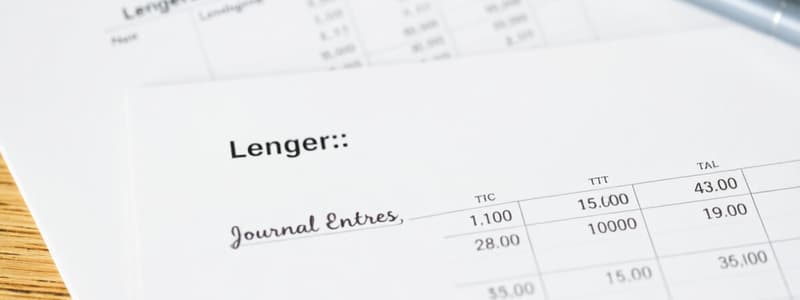Podcast
Questions and Answers
A personal ledger consists of accounts named after individuals or businesses.
A personal ledger consists of accounts named after individuals or businesses.
True (A)
An impersonal ledger records transactions that are associated with a person's name.
An impersonal ledger records transactions that are associated with a person's name.
False (B)
The cash book is used to record all accounts receivable.
The cash book is used to record all accounts receivable.
False (B)
In a Sales Journal, debtors' accounts are debited while the Sales account is credited.
In a Sales Journal, debtors' accounts are debited while the Sales account is credited.
The Purchases Journal debits the creditors' accounts and credits the purchases account.
The Purchases Journal debits the creditors' accounts and credits the purchases account.
A trial balance is prepared to test the equality of debit and credit balances.
A trial balance is prepared to test the equality of debit and credit balances.
All ledger accounts with zero balances should be included in the trial balance.
All ledger accounts with zero balances should be included in the trial balance.
Errors of omission can be detected by a trial balance.
Errors of omission can be detected by a trial balance.
When preparing a trial balance, the heading includes the title of the company and the date.
When preparing a trial balance, the heading includes the title of the company and the date.
Errors in addition in ledgers can lead to a balanced trial balance.
Errors in addition in ledgers can lead to a balanced trial balance.
Flashcards
Personal Ledger
Personal Ledger
A ledger that records transactions with specific individuals or businesses, like customers (debtors) or suppliers (creditors).
Impersonal Ledger
Impersonal Ledger
A ledger that records transactions not related to specific individuals or businesses.
Sales Ledger
Sales Ledger
Used to track all accounts receivable (money owed by customers).
Purchase Ledger
Purchase Ledger
Signup and view all the flashcards
General Ledger
General Ledger
Signup and view all the flashcards
Trial Balance
Trial Balance
Signup and view all the flashcards
What is the main purpose of a Trial Balance?
What is the main purpose of a Trial Balance?
Signup and view all the flashcards
What does the Trial Balance help with besides balancing the ledger?
What does the Trial Balance help with besides balancing the ledger?
Signup and view all the flashcards
How do you prepare a Trial Balance?
How do you prepare a Trial Balance?
Signup and view all the flashcards
What are some limitations of the Trial Balance?
What are some limitations of the Trial Balance?
Signup and view all the flashcards
Study Notes
Financial Accounting 1 - Topic 4: Journal, Ledger, and Trial Balance
- Ledger: A book of accounts that holds detailed records of transactions. It's crucial for tracking financial activity.
Types of Ledger
-
Personal Ledger: Contains accounts for individuals or businesses, e.g., debtors, creditors. Accounts are headed by the name of the person or business.
-
Impersonal Ledger: Records transactions not linked to a specific person or business.
Types of Ledger (Specific Ledgers)
- Sales Ledger: Lists all accounts receivable (money owed to the business).
- Purchase Ledger: Contains all accounts payable (money owed by the business).
- General Ledger: Includes all accounts other than those in sales and purchase ledgers, such as cash and bank accounts.
- Cash Book: Specifically tracks cash receipts and payments.
Journal Entries Posting to Ledgers
- Cash Receipts Journal: Records cash received, Credits cash account, Debits accounts indicated in particulars.
- Cash Payment Journal: Records cash payments, Debits cash account, Credits accounts indicated in particulars.
- Petty Cash Journal/Cash Book: Records small cash transactions. Credits petty cash and debits respective accounts.
- General Journal: Handles all other transactions, Debits and credits accounts as appropriate.
- Purchases Journal: Records purchases on credit, Debits Purchases account, Credits creditors accounts.
- Sales Journal: Records sales on credit, Debits debtors accounts, Credits Sales account.
- Return Inward Journal: Records returns of goods by customers, Debits return inward account, Credits debtors account.
- Return Outward Journal: Records returns of goods by the business, Debits credit account, Credits return outward account
Ledger - 3 Column
- Example: Paying electricity RM100 by cash.
- Dr. Utilities (electricity) RM100
- Cr. Cash RM100
Trial Balance
- Purpose: Verifies the equality of debit and credit balances for accounts. Locates potential errors. Aids in preparing financial statements.
- Process:
- Lists all ledger accounts with their balances at the end of an accounting period.
- Accounts with zero balances are excluded.
- Transfers debit and credit balances to their respective columns.
- Totals the debit and credit columns. These totals should be equal.
- Example: A table outlining accounts, their debit and corresponding credit balances. Debits equal credits.
Limitations of Trial Balance
- Errors:
- Omission of entries
- Errors in addition within ledgers
- Incorrect posting of entries to accounts
- Mistakes in totalling the trial balance can happen
- Trial balance does not show all possible errors.
How to prepare a Trial Balance
- Heading: Include the company name and "Trial Balance as at..."
- Balance Transfer: Transfer debit and credit balances accurately into their corresponding columns.
- Totals: Calculate the debit and credit column totals. They should balance.
Financial Statements
- Purpose: Present financial information to show the company's financial position and performance.
Studying That Suits You
Use AI to generate personalized quizzes and flashcards to suit your learning preferences.



